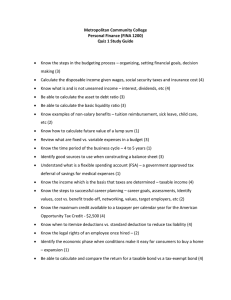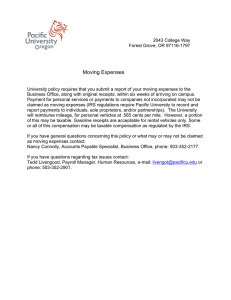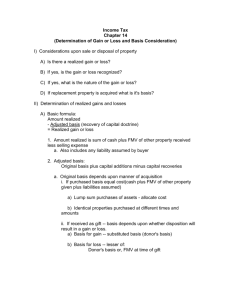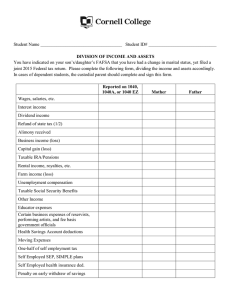§ 61 means all income from whatever source... in an employment context is a benefit provided that would...
advertisement
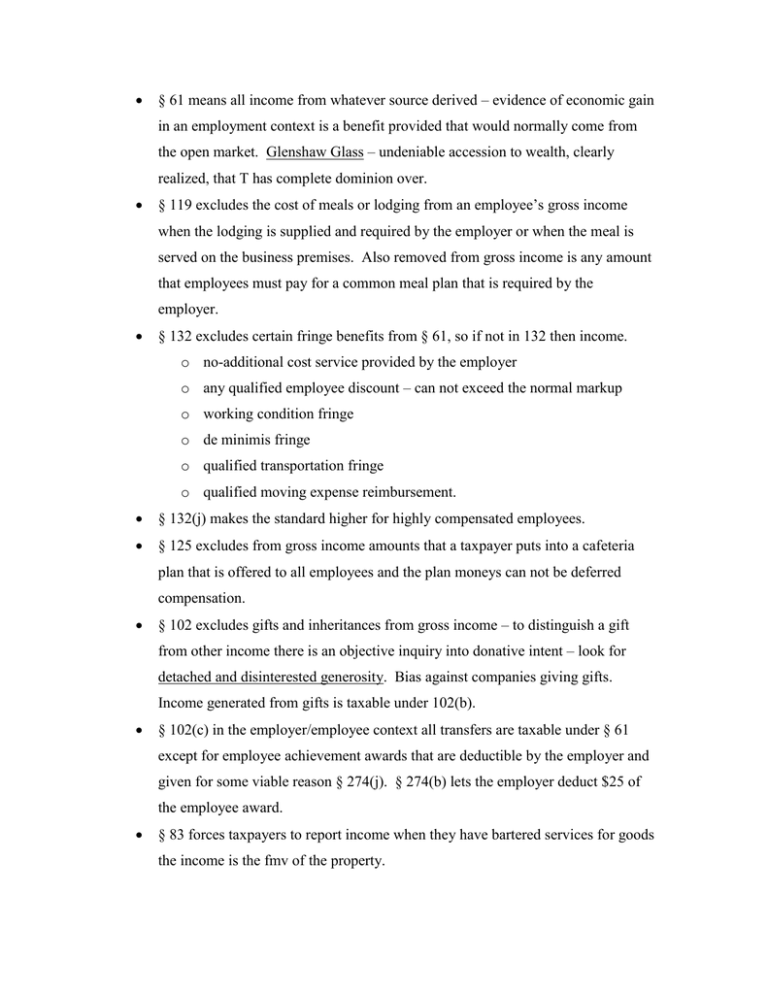
§ 61 means all income from whatever source derived – evidence of economic gain in an employment context is a benefit provided that would normally come from the open market. Glenshaw Glass – undeniable accession to wealth, clearly realized, that T has complete dominion over. § 119 excludes the cost of meals or lodging from an employee’s gross income when the lodging is supplied and required by the employer or when the meal is served on the business premises. Also removed from gross income is any amount that employees must pay for a common meal plan that is required by the employer. § 132 excludes certain fringe benefits from § 61, so if not in 132 then income. o no-additional cost service provided by the employer o any qualified employee discount – can not exceed the normal markup o working condition fringe o de minimis fringe o qualified transportation fringe o qualified moving expense reimbursement. § 132(j) makes the standard higher for highly compensated employees. § 125 excludes from gross income amounts that a taxpayer puts into a cafeteria plan that is offered to all employees and the plan moneys can not be deferred compensation. § 102 excludes gifts and inheritances from gross income – to distinguish a gift from other income there is an objective inquiry into donative intent – look for detached and disinterested generosity. Bias against companies giving gifts. Income generated from gifts is taxable under 102(b). § 102(c) in the employer/employee context all transfers are taxable under § 61 except for employee achievement awards that are deductible by the employer and given for some viable reason § 274(j). § 274(b) lets the employer deduct $25 of the employee award. § 83 forces taxpayers to report income when they have bartered services for goods the income is the fmv of the property. BASIS § 1001 – gain or loss from a sale of property is the excess of amount realized minus the adjusted basis provided in 1011. § 1011 – Lets you adjust basis to determine gain or loss as allowed by § 1016. § 1016 allows you to adjust the basis of property for expenses properly chargeable to a capital account. § 1012 – the basis of property is its cost unless otherwise adjusted. § 1014 gives property passed through inheritance a fmv value at the date of death but § 1015 gives a donee his donor’s adjusted basis in the property transferred by gift, but when the donor gives away property whose fmv is below the donor’s basis, then the donee takes the fmv value at the time of transfer as his basis. 102(b) allows donee’s to be taxed on the income that a gift generates, but the gift itself is not taxed. When there is an action that affects the entire property or part of the property, then T must make some effort to allocate the revenue to basis or report it as income. If a taxpayer overpays his taxes and gets a refund from a preparer or gov’t then that income is not taxable based on a recovery of capital princple. Taxes are paid on post tax income, so not taxing a refund or money paid for an error is like a recovery of basis in a property sale. When T receives earnings under a claim of right and without restriction as to its disposition, he has received income and must pay taxes on it. This must be done even though T may have to repay the money at a later date due to court decision, error. The harshness of this is lessened by § 172— T can take losses back three years or forward 20 years. When T reports income in Year 1 that was wrongly received and in Year 2 he must repay the income, 1341 gives him two options. Either he can deduct the amount that he has to repay from his Year 2 income 1341(a)(4) or he can calculate the tax paid on the wrongfully reported income and subtract that from the tax that he owes on his Year 2 income (a)(5). If T’s tax rate stays the same for Year 1 and Year 2, then it makes no difference which route T uses. If T’s tax rate is higher in Year 2, then T will elect (a)(4) to shelter more income in Year 2. If T’s tax rate was higher in Year 1, then T will use (a)(5) to get a tax credit in Y2. § 111 – Tax Benefit Rule. When T has his car stolen and it is not insured he can take a deduction Year 1, but if the car is returned to T unharmed in Year 2 then he must report the value of the deduction that T took in Year 1 in his Year 2 income. There is no option on how to handle the reporting, but if the deduction/loss did not benefit the T in anyway then he does not have to include the income. § 104 – prevents taxation on personal injury settlements for physical injuries/sickness -- § 104(a)(2) allows for deferred settlements that gain interest to go to injured parties tax free. § 61(a)(12) allows for taxation of income derived from a discharge of indebtedness. § 108 defines indebtedness as any debt that (a) the taxpayer is liable for or (b) subject to which the taxpayer holds property. Not all discharges of indebtedness are income under 61(a)(12) – For example B gives A $10K and A uses it to pay off a loan. The gift is not income under 61/62 even though it was used to discharge a debt because it is a gift. Transfers of Property Subject To Debt When T abandons a nonrecourse mortgage property, the amount realized by T is the face amount of the mortgage attached to the property and any cash payments T got for transferring the property. This is because mortgage indebtedness is included in “amount realized” when property is sold because it is also “included” in “adjusted basis.” Ex: T borrows $100K to buy a house – T’s basis in the house is $100K. Mortgage indebtedness makes a huge difference when T wants to depreciate property because T will use the mortgage as basis because the mortgage is usually “cost” under 1012. There is a split of opinion on what happens to basis of a new buyer when the nonrecourse debt exceeds the fmv value of the property. Pleasant Summit – would give T a basis of his cash payment and the fmv of the property while Franklin – would just give T a basis of his cash payment. When the mortgage exceeds the fmv value of the property and T has taken depreciation deductions, then the T must account for obligations gained tax free and included in basis. If nonrecourse debt is treated as cash when determining basis, then it should get the same treatment upon a sale. Tax and economic losses are harmonized. Ex: T buys property with a $1 M nonrecourse mortgage and through depreciation takes the basis down to $500K without paying on the mortgage. When T sells the property, he must use his adjusted basis as a basis and the full value of the mortgage passed on with the property and any cash payments as “amount realized.” James Test -- When T takes money (legally or illegally) w/o the recognition of an obligation to repay and w/o restriction upon use, then T has realized income and must report it. But when T uses corporate money for a purpose that he thinks will be approved by the company, then it is not income to T. Gains/Losses From Property § 1001(b) Any gain or loss from property must be realizable through sale or other disposition. § 109 says that gross income does not include income (other than rent) derived by a lessor of real property on the termination of a lease gained from improvements by the lessee. The income is just recognized – the basis is not altered in anyway. If T takes out a mortgage beyond the original amount he mortgaged the property for, then there is no taxable event –when T sells the property there will be a taxable event. § 1001(a) gives rise to realization only if the properties exchanged are “materially different” – look for legal entitlements that are different in kind or extent. When there is a different in entitlements, then both parties can determine the change in value. A material difference is one that has the capacity to influence a decision. Losses have to follow the same rules as gains – mere impairment in value is not a loss if it is not recognized or realized. A loss could be recognized if T sold the property whose value has dropped. When T enters a transaction that entitles T to a series of cash payments, then T has three options. o Open Transaction – T keeps the payments until his basis in them is reached, then T starts to record income. o Closed Transaction – T calculates the present value of the payment stream and anything over the basis is taxed in the current year. o Mixed – An open transaction where basis is allocated throughout the payment cycle – (limited to when the sale price is contingent or when fmv value of the obligation can not easily be calculated.) § 453(c) – forces T to recognize every taxable year the portion of the payment going towards profit/gain. Thus, T is required to divide the realized gain over the term of the K and T must report that amount each year. T can use § 453(d) to opt out but it is very difficult. Constructive Receipt – income is received when it is made subject to the will and control of T and can be reduced to his actual possession if he wants. Ex: a cash basis T can not be forced to have realized income on a promise to pay; when T K’ed to be paid in Year 2, but the K was signed in Y1 there is no constructive receipt. More often that not, economic benefit to T compels a recognition of income b/c the ability to use money as collateral is an economic benefit under § 61. A T is taxed when he actually gets trust income when the trust is unfounded, unsecured, and subject to a risk of forfeiture – if T has a claim of right to the funds then he is taxed at that time. If T chooses to rearrange his payment schedule then that is allowed – an alteration of K rights is a novation and will result in a delay not deferment of taxation. § 1041 says that T does not have to recongize gain or loss on transfers of property between spouses incident to divorce. The property transferred in divorce proceedings keeps the transferor’s basis § 1041 does not allow for the same treatment of property exchanged through ante nuptial settlements. Alimony is deductible to the payor (215) and income to the recipient (71). 1031 T can delay recognition from a sale or disposition of property by exchanging it for like kind property. Like Kind property is considered of the same nature or character – a difference in quality or grade is generally disregarded. Exceptions: Leaseholds for over thirty years are considered similar to ownership interests; thus, a sale and long- term leaseback transaction may count as an exchange. The following are excluded from like-kind swap treatment. You can not recognize a loss in a 1031 swap. o stock in trade/property held for resale o stocks, bonds, notes, and other securities or evidence of indebtedness o partnership certificates o certificates of trust and beneficial interests o choses in action Cash “boot” may be received in addition to like-kind property. If boot is received and the recipient would otherwise recognize gain on the exchange, then that gain is recognized to the extent of the boot received. Under 1031(b) you do a 1001 analysis to get the amount realized. T will report the boot or the amount realized whichever is less. Basis in 1031 – In a straight swap, T’s basis remains the same as he had in the old property. In a 1031 swap where boot was paid, T’s basis in the new property is his basis in the old property minus the boot received plus any gain recognized under 1001 as a result of the transaction. This is T’s new basis in the property. Personal Deductions § 262 makes it clear that there is no deduction for personal, living, or family expenses, but there are a number of specific exceptions… § 165(c)(3) allows a deduction for losses from “fire, storm, shipwreck, or other casualty, or from theft” but only when losses exceed 10% of gross adjusted income. There must be some element of suddenness to qualify and the loss can not be compensated for by insurance. There is also some question of T’s N or intent when a loss has been suffered. § 213 – a deduction for medical expenses (not compensated by insurance) that exceed 7.5% of AGI. Medical expenses can not be stretched using “but for” – ex: expenses for child care b/c T was injured is not a medical expense. § 170 – allows a deduction for donations to charitable organizations defined by 301. But in some cases IRS will examine T’s intent in making the donation – if T expects or receives a substantial return or benefit for his gift, then the charitable gift is not exclusively made for public purposes and is not deductible. § 67 applies to individual Ts and requires them to have enough deductions to exceed 2% of adjusted gross income before they can take any. Does not apply to selfemployed individuals, but would apply to employees. For the definition of charity we look to English common law – a charity must serve and exist in harmony with the public interest. § 183 – Denies deductions for activities that are not undertaken for profit. For Hobbies of T, that might produce a profit but it is not T’s intention to make a profit, then T can deduct losses only to the extent of profit. Business Related Deductions § 162 allows T to deduct all ordinary and necessary expenses paid or incurred during the taxable year for carrying on a trade or business. The test of whether or not T is engaged in “trade or business” – Is T actively pursuing an activity with some regularity or continuity and does he intend to earn a profit? What is “ordinary and necessary?” To qualify the expense must be common to T’s business community and helpful and appropriate to the business. This might allow a company to overpay an employee if there is a valid business reason for the expense. But the general rule is that they are deductible. Repairs/Maintenance are ordinary and necessary as are salaries paid for personal services. When T makes an expenditure for an asset that last longer than a year, then § 263, not § 162 applies. § 162 allows for a deduction in the current taxable year, but § 263 forces T to depreciate the property over time. Ex: T spends $1 M to create the encyclopedias that it will sell for the next ten years – T must depreciate it. What if T, a company, pays $300K for a new building, but only makes $100,000 that year does § 162 allow it to pay no taxes? No, T must depreciate the property under § 263. § 263 denies any deduction for money paid out for new buildings or to improvements to property. When T tries to deduct expenses that are part personal and part professional, then § 262 controls and no deduction is allowed. There has to be some nexus between T’s expenses and the carrying on of T’s business Commuting Expenses – expenses to and from work are not deductible, but expenses incurred to travel to “non-regular” locations can be deductible if the employer requires such travel. § 21 grants an exception for child care – T must take § 21 credit rather than just an unlimited deduction under 162 for allowable child care costs. § 274 severely limits deductions under § 162 and § 212 for expenses for entertainment/travel etc. unless the T keeps detailed records 274(d) and spouse expenses are not deductible under 274(m) – the meal can also not be lavish 274(k). § 212 – An individual can deduct all the ordinary and necessary expenses incurred to produce or collect income, to manage/maintain property held to produce income, or to collect a refund on any tax owed. Deductions under § 212 are subject to 274’s limitation on entertainment/lodging expenses and § 280A which prevents T from deducting the use of his dwelling in connection with his business or trade. Ex: A doctor can not deduct his entire home just because he has an office in his house where he gets official mail. Splitting of Income Income from services can not be assigned away through a K to avoid taxation, but if state law entitles a spouse to a share of income then an equal share must be reported by each taxpayer. An employee must report in gross income amounts paid by his company because of his status into a company run educational trust. Individuals can not assign around § 61 – if state or federal law does that for you, then you will not have to report income. Ex: An employer gives a free benefit to all employees that is allowed by the tax code, then T is not taxable. As for assignors/donors, the Tax Code draws a distinction between the types of transfers and the tax consequences that they can create. T can not assign income from services and escape taxation. T can assign income from property and escape taxation, but this income under § 102 must be reported by the donor/assignee. If T assigns away an interest that runs with his a “horizontal slice” has been given, then that is a valid assignment and the income is not taxable to T. Ex: T gives S a piece of property – the income from the property afterwards is taxable to S. But, if T gives S a $50 check, then only a gift has been given so T must include the $50 in his income, but S does not have to report this as income since it is a gift. Capital Assets Some income derived from capital assets is taxed at lower rates than regular income if owned for longer than one year. There are many reasons for this. Ex: If T buys a house in Year 1 and sells in Year 10, then part of the sale price is inflation, the property has gained value every year, to tax at regular rates would encourage people to hold onto property, and incentives for investment. § 1221 – defines a capital asset and includes a number of exceptions to prevent T from moving ordinary income into capital asset income for lower tax rates. §1211 – discusses capital losses – for corporations, they can only take capital losses to the extent of their gains. For individuals, they can offset capital gain with capital losses, and can offset up to $3000 of ordinary income with capital losses once they have used all of the capital gains for the taxable year. The quality of an investment can change – “once an investment does not mean always an investment.” We look at how T has treated the property over time to tell us how to handle the income. Ex: T purchased a large tract of land and used it for farming for a while, but over time began to subdivide and improve it. He later hired an agent and bought advertising to sale the property. The court determined that this land became inventory and should be treated as ordinary income. However, another T got capital gains taxation for land parcels that he sold because he had made no effort to advertise or sell the property and had not put any effort into developing or improving it. “holding purpose” used to be a question of law – now considered more a question of fact held to a clearly erroneous standard on appeal. When a T purchases futures to assist the everyday running of the business and not for investment purposes, then the income is taxed at ordinary rates. This is modified by a later Supreme Court decision that held that the motive of a T when they make an investment is irrelevant – if the stock fits the description of a capital asset that is not held for sale to customers, then it gets capital asset treatment. You can not get capital asset treatment and an offsetting basis to on who disposes of a right to future income which has been carved out of a larger estate. Similar to the “horizontal/vertical slice of property for ordinary income.” However, if you sell of your portion of life income in a trust, then that is a capital asset – just like if you sold a life estate in a piece of land. Further, you can not assign ordinary income to a capital asset to get better tax rates. Ex: A T working for a company can not accept
